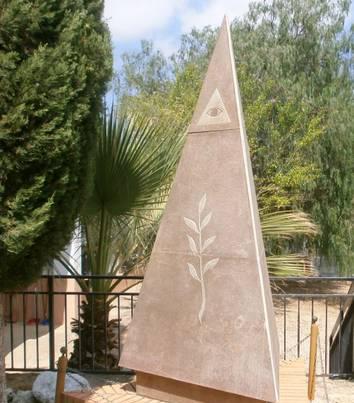
Buñol has a reputation for being a bit different, and to be different in a country that is already a bit different, is quite an achievement.
Buñol has for many years been a town that has had a strong left-wing and progressive population, and if among the living that tendency has mellowed in recent years, among the dead of Buñol it is manifest in the place where such things belong.
Buñol cemetery is unique in Spain. It was opened in 1886, and was the project of the then Mayor and freemason, Joaquín Ballester, whose own tomb is located in a prime position facing the other tombs and situated as if on the podium of an orchestra conductor. It is thought that the design of the graveyard is supposed to represent the Temple of Solomon. Furthermore, the second entrance to the cemetery actually has a masonic engraving above the threshold.
All of this was explained to me by Rafael Casero Alcañiz, a Valencian lawyer whose family comes from Buñol, and whose grandfather was a Mayor there.
Rafa is one of many people from Buñol who are trying to recuperate the town’s traditions, one of which is the widespread adhesion to masonic principles.
The cemetery, about which Rafa has published two books, has 1,700 masonic symbols located on 465 masonic tombs, dating back to the 19th century, and with the most recent addition in 2010.
Considering that Buñol has a population of a mere 4,000 inhabitants, that makes it the most significant masonic burial place in Spain and probably in the whole world, a fact that was recognised on 1st November 1995 when all four of Spain’s masonic lodges held a ceremony of homage in the graveyard.
Rafa’s books explain the symbolism of each graven image and how they have adapted throughout history, particularly during the dictatorship of Franco, when freemasonery was punishable by death, despite the fact that Franco’s own brother ramón was one. Malicious rumours say that this was due to Franco’s being refused admission to a lodge, in the same way that Hitler’s hatred of the Jews was founded in the suspicion that he himself had Jewish ancestry.
Under Franco, nobody could be buried without the sign of the cross, and so during that period, crosses were woven into masonic symbology so as to meet the minimum requirements on the 60 graves created during that period.
Rafa now works to achieve a reversal of the dedgradation of many tombs, so that they can be conserved, as part of Buñol’s heritage, and even as a tourist attraction.
The cemetery is open most days from 10 to 1.
